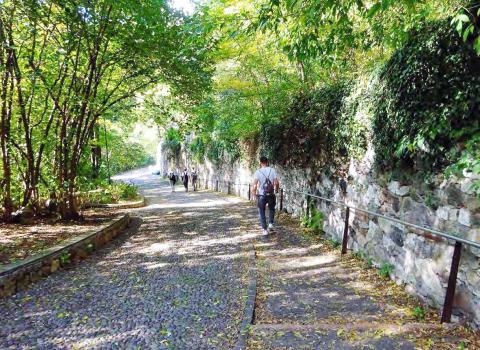Along the river Fersina, from the city to Povo
- Start point: Piazza Venezia
- Arrival point: Chiesa Oltrecastello
The trail highlights different types of environments. After the urban area with the tree-lined street of via Grazioli, you will see the gorge landscape, carved by the river Fersina in the deep calcareous substrates, that are perfectly visible from Orrido di Ponte Alto. Here, the water allows the presence of a natural habitat, characterised by hygrophilous species like alders, poplars and white willows.
Passed Cornicchio Bridge, rebuilt at the end of the 18th century, go up the first cliff, walk on the characteristic Manci ascent and reach the plateau between Mesiano and Panté, where you will find a vineyard landscape. Here, particularly important is the historic aspect with the presence of monuments and the "villa landscape", typical of this hilly region. In this area you will find Villa Penner, Villa Gherta, Villa Garbari and Villa Saracini.
The way up to the Valoni street, squeezed between high stone walls and surrounded by orchards and vineyards, gives the impression of a strong rurality that had to be felt until the middle of the 20th century, when the building expansion had not yet transformed these areas.
From Panté di Sotto, crossing the square that was the politics and religion's heart of the hill of Povo, suburb divided into Villa Bassa and Villa Alta. Around the square there was the town hall, the fountain, the mulberry tree under which the assemblies usually met and further on there is the Pieve complex.
Heading eastwards, go up to the old route connecting Pantè, Sprè and Oltrecastello; on the side flows the river of Salè that is one of the main streams that collects the waters of the whole moraine terrace of Povo-Villazzano. Here there are a lot of patrician villas, that witness the representative social value of the hill of Trento from the 15th century. In those years the noble and urban bourgeois families settled their summer residences. In the following centuries the villas were adorned with parks of different dimensions, rich with exotic plants and monumental trees (Villa ex-Thun, Villa Cavagna, Villa Ceschi), whose remains are still well recognisable.
Before reaching the square of Oltrecastello, you can do a little detour to Doss S. Agata (575 m), one of the three hills from which Trento takes its name. The relief, morphologically suited for hillfort (in Italian "castelliere"), has been attended since prehistory while in medieval ages (13th century) was home to a community castle. The 16th century church of S. Agata, that rises on the top, carries on the tradition.
The steep eastern side of the relief is covered with a thick broadleaf forest, while the southern slope is topped with a dense plot of terraces, many of which are abandoned. These are the "frate", lands of common property that were rented to the members of the community.
For further information and details go to OUTDOORACTIVE
Safety tips
The information on this page is subject to change, so this means that none of the indications are absolute. It is impossible to completely avoid inaccuracies, taking into consideration the rapid environmental and weather changes that may occur. Therefore, we decline any responsibility for any damage caused to the visitor. However, it is strongly suggested to check the path state, the environmental and weather conditions before going on an excursion.
The Network of Bondone Nature Reserves is not responsible for the management and maintenance of the trails. Therefore, we decline any responsibility for damages that can occur to people, animals or objects.
- Prepare your itinerary
- Choose a trail suitable for your training
- Choose adequate equipment
- Consult weather reports
- Going alone is riskier
- Leave information about your itinerary and the time you expect to get back
- Do not hesitate to go with an expert
- Mind the indications and signages on the path
- Do not hesitate to go back the same way you came
- In case of an accident call the standard emergency number 112
